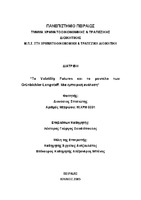Τα volatility futures και το μοντέλο των Grunbichler-Longstaff : μια εμπειρική ανάλυση

Master Thesis
Συγγραφέας
Σπατιώτης, Διονύσιος
Ημερομηνία
2005-01-01Προβολή/
Θεματική επικεφαλίδα
Future marketsΠερίληψη
This dissertation examines the properties and the valuation framework of a specialized financial product, volatility futures. Volatility futures belong to the category of volatility derivatives - a new class1 of derivative instruments whose underlying asset is volatility, specifically an implied volatility index. These products emerged to satisfy the need for instruments and ways to manage volatility risk, the exposure to changes in volatility of an asset. Volatility risk is an important risk behind many investors' positions and it is assumed to have played a major role in several financial debacles (eg. Barings, LTCM) We are interested in examining the pricing performance of volatility futures under the model of Grunbichler-Longstaff2. The model's accuracy will be assessed further within a value at risk study. These tests will regard the volatility futures contracts of the Chicago Board of Options Exchange which are written on the VIX Implied Volatility Index. Our aim is twofold: testing the model by examining how well it fits market prices and asserting whether a value at risk methodology is effective under the model and the respective process for volatility. To examine the pricing performance we will implement a technique that is approved by econometric theory and is also common in applied research, calibration. This procedure involves fitting the model to a specific sample of market data in order to get estimated values of the model's unknown parameters and examining the pricing performance of the model in another sample where the deviation between derived model and real prices is calculated (out of sample performance). As for the value at risk study is concerned, we will assume a position in the VIX Index and in a volatility future contract and we will derive daily value at risk figures using a Monte Carlo Simulation approach. Then we will implement a back testing procedure in order to verify the validity of the value at risk model. In order to have a measure of comparison, the same study will be conducted also within the context of another pricing model - a benchmark model. This model's assumptions are simpler compared to the one of Grunbichler-Longstaff's and the pricing formula resembles the one of standard (equity) futures. The results of the two models will be compared with the aim to investigate which volatility process is supported the most by the data. The answer to this question is important not only in the context of volatility derivatives but also for the broad area of volatility modelling.


